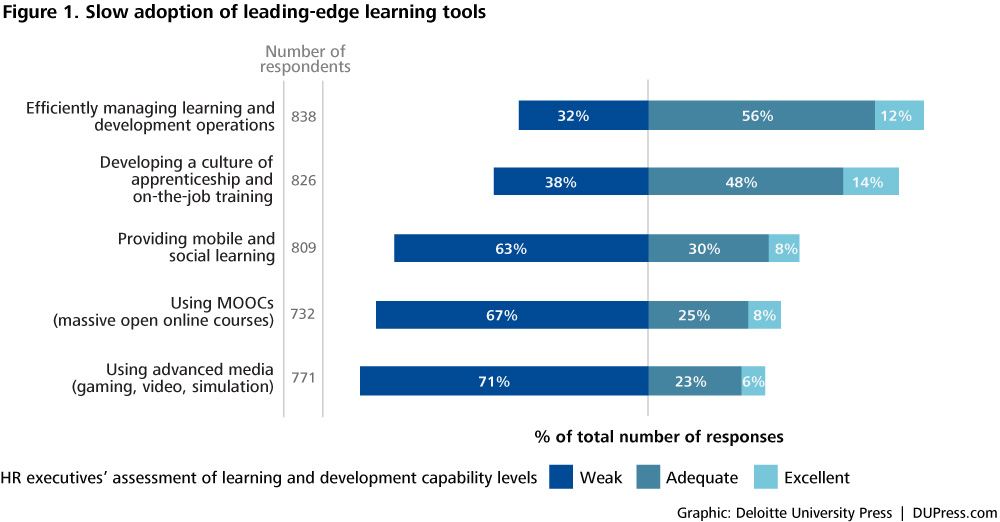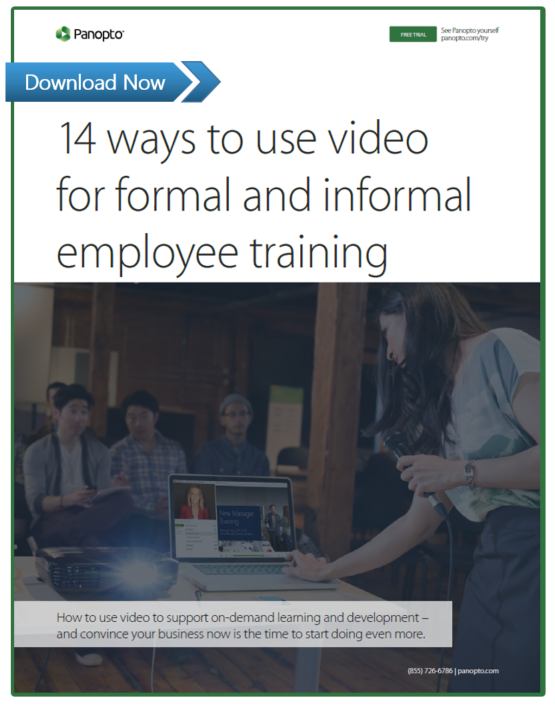- Live & Recorded Events
Powering Today’s Corporate Universities With Video

Born out of the manufacturing boom of the 1950s that followed World War II, corporate universities at organizations like General Motors (GM) and General Electric (GE) were some of the earliest leaders in the workforce learning movement. Their goal was not only to train employees consistently on important skills and processes, but also instill the company vision in all their trainings — giving employees a better overall understanding of how they can help the company succeed.
Strategic corporate training programs have only become more prevalent as technology advancements, globalization, and the shift from industrialism to an information-based economy has inspired companies to be more intentional when it comes to training and sharing institutional knowledge in order to maintain a competitive advantage.
Human Resources analyst Josh Bersin has spent years researching and analyzing many top businesses, and has drawn a simple yet surprising conclusion:
“Companies don’t fail to innovate. They simply fail to learn.”
And in working to sharpen their competitive advantage, today’s learning and development (L&D) leaders are evolving the corporate university models of yesterday to support continuous learning within their organizations. Employee training methodologies within the corporate university still rely heavily on instructor-led training, but increasingly they are putting employees in charge of their own learning.
From recording and sharing process walkthroughs to searchable on-demand training videos for just-in-time learning, corporate universities are adding to their top-down dissemination of critical information by also encouraging more “social learning” from the bottom-up.
Related Reading: Social Learning Vs. Knowledge Management: What’s The Difference?
Digital media technologies help make blended training strategies successful and scalable. Many businesses, though, got off to a somewhat slow start when it came to adopting new technologies that help empower employees to become equal partners in the learning process and in the sharing of institutional knowledge.
Research performed by Deloitte just a few years ago in 2014 showed that 71% of HR executives believed they were weak in using advanced media like gaming, simulation, and video software to support learning within their organizations.

Source: Deloitte Insights: Corporate Learning Redefined
Fast-forward a few years and new data collected by Wainhouse Research shows the high-value employees place on video-based learning as a part of onboarding, skills training, and career development. According to Wainhouse:
- Nearly seven of eight employees agree that pre-recorded training videos are valuable, providing access to information when they need it most.
- 88% of employees agree that on-demand videos created by subject matter experts are valuable when working on a new or unfamiliar task.
- Four out of five respondents agree that coaching and mentoring done via self-recorded videos would be an effective way to improve skills.
- And more than four out of five agree that online training sessions allow access to higher quality instructors.
When asked about the usefulness of videos on their companies’ internal sites, however, three-quarters of the employees surveyed said they find more useful videos on the Internet than they do on internal sites. This suggests that there is still ample opportunity to for corporate universities and L&D teams alike to really put video learning to work.
4 Ways A Video Platform Can Help Build Your Corporate University
1. Live stream corporate university courses and make them available on-demand
Instructor-led courses are at the heart of every corporate university. But scheduling and logistical challenges make it nearly impossible for every employee to attend a course, requiring instructors to host multiple sessions, often in different locations.
A video platform enables corporate universities to scale access to training sessions, allowing more time for the creation of new course content. Instructors can easily set up and stream live broadcasts of their courses with Panopto, which are automatically recorded, and then make them available for on-demand viewing immediately following the session. Viewers can pause or rewind the live broadcast, or even start from the beginning if they tune in late. And after the course ends, anyone within your organization can find the video with a simple search of your video library.
2. Break down organizational silos
For many corporate universities, a primary goal of the program is to help employees better understand how they can contribute to the success of the business. And productive teaming across departments is often the key to the most impactful projects. Cross-departmental training can remove barriers and break down silos between teams, regardless of whether teams are located in the same building or different cities entirely.
Video can help employees better understand how each part of the business functions by learning the basics directly from leaders of each group. In a video platform like Panopto, all of those videos are searchable and available on-demand, so they can be watched at any time.
3. Provide video-enabled coaching and mentoring
Coaching and mentorship programs within corporate universities can also be supported with video. Simply recording and reviewing conversations or performance reviews with a coach can make is easier to review action items and develop a plan for success, particularly if scheduling face time is challenging. Video recordings can also be used to demonstrate a skill or simulate role play, which can help professional coaches actually see an employee’s progress. A coach can even add comments and notes within a Panopto video to highlight where an employee is working at their best or to deliver better feedback when they may be going off-track. Here video can serve as an objective witness, helping coaches or mentors recall specific moments and offer more detailed feedback.
4. Integrate video learning into other business systems
As beneficial as video learning is, some businesses don’t use it as much as they would like to because video has traditionally been hard to capture and even harder to share and store. An all-in-one video platform makes everything about video easy — from creation and curation to storage, search, and sharing — even incorporating video learning into the business systems you already use is simple with Panopto.
Panopto’s video platform integrates with learning management systems, content management systems, enterprise portals, and more to make your corporate university content even more accessible and useful. This means you can embed, find, and even manage video learning within the existing systems that you currently use to support your corporate university.
Learn More Ways A Video Platform Can Support Your Corporate University

In our complete white paper, 14 Ways to Use Video for Formal and Informal Learning, we help corporate university leaders and L&D practitioners make the business case for doing more with video, including:
- 5 benefits that help convince your decision makers to use video in more ways
- 14 ideas for supporting and scaling formal and informal learning with video
- 1 technology — the video platform — that simplifies the use of video
Today’s learning and development professionals already understand the potential that video technology offers. Make sure your organization using today’s technologies to their fullest potential!
Download your free copy today!




